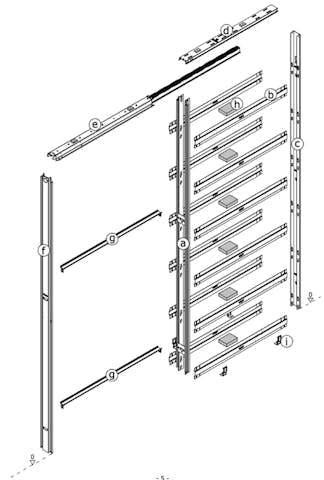
What is a pocket door frame?
A pocket door frame is a structure that houses a pocket door, allowing it to slide in and out of a wall cavity rather than swinging open. The frame includes a track system to guide the door, and it’s integrated into the wall to support the door’s movement. This space-saving design makes it easier to place furniture and décor closer to doorways, which is ideal for rooms where floor space is limited.
Which pocket door frame do I need?
The pocket door frame you need is dependent on your specific needs, such as your room size and style preference. There are various frames available, all with different sizes and finishes to choose from. The three main types include glass pocket door frames, wooden pocket door frames and fire rated pocket door frames. Glass and wooden door frames are more commonly used in homes for their aesthetically pleasing design, while fire rated frames are typically used in commercial spaces or areas where fire safety is a concern, such as between a garage and living areas. It's important you choose a pocket door frame that's durable and reliable. Klug, for example, offers a range of pocket door kits that are designed for easy installation and are suitable for various applications.

Fitting pocket doors in stud vs solid walls
Before beginning to install a pocket door system, it’s important to understand whether your wall is a stud or solid wall, as this is likely to affect the process. Stud walls are common in modern homes and are generally easier to adapt for pocket door installation, especially if plasterboard is removed from both sides of the wall. Check your stud wall for any internal wiring or plumbing before installing a pocket door frame.
Solid walls require more effort if you want to fit a pocket door frame, as you either need to create a cavity within the existing wall or build a false wall alongside it. Whether you have a stud or solid wall, it’s important to ensure the cavity is roughly twice the width of the door, with enough space above for the frame. Before beginning the installation, you need to fit the kit to the finished floor level and paint or stain the door.
Equipment you’ll need to fit a pocket door frame
Having the correct equipment is essential for a successful pocket door frame installation. The equipment you’ll need includes:
- Pocket door frame system
- Spirit level
- Mallet
- Drill
- Gloves
- Measuring tape
- Plumb line
- Screwdriver
- Handsaw
- Stud finder
- Pencil or marker
- Safety glasses
Common pocket door installation mistakes & how to avoid them
While pocket door frame installation can be a fairly simple task with the correct guidance, there are tips you should be aware of before beginning. This will help you to avoid common mistakes and ensure the process runs smoothly.
Incorrect measurements
Having accurate measurements of the door opening and frame is essential for a successful installation. You should double-check the dimensions before purchasing a frame to ensure the measurements of both height and width are correct. If you’re unsure of the measurements you need to fit door furniture, read our blog for further guidance.
Not properly levelling the frame
Not properly levelling the door frame when completing a pocket door installation will result in the door not sliding smoothly. You should always use a spirit level to make certain the frame is perfectly vertical and horizontal before securing it in place. By doing so, you are ensuring proper functionality of your pocket door.
Overlooking the wall reinforcement
Pocket door frames require a solid wall reinforcement to ensure stability. Failing to secure the frame to the wall studs or not using a stud finder can lead to the pocket door becoming unstable. Depending on the wall, stronger wall studs may be required.
Poor track and alignment
Misaligned tracks can cause the pocket door to slide unevenly or even derail from the frame. Check that the track is securely fastened and aligns with the frame. The alignment should be checked before placing the door on the track.
How to install a pocket door
Once you have the necessary tools at hand, you can begin installing your pocket door. This task will be made even easier by following the tips and tricks outlined in our guide.
Step 1: Prepare your workspace
The first step for a pocket door frame installation involves preparing your workspace. Lay out all of the components and tools in a clear and flat area, making sure you have everything you need before beginning. Unpack the pocket door frame system and read through the instructions carefully to familiarise yourself with the components.

Step 2: Assemble the frame
To begin assembling the frame, fix the bottom vertical pieces to the base using the pre-drilled holes. Once secure, attach the top track to these vertical pieces and flip the frame, and repeat for the opposite side. Repeat this process with the other two vertical pieces to complete the basic frame structure. For this step, you will need a screwdriver, a drill, and a mallet.
Step 3: Prepare the wall cavity
After the frame is assembled, the wall cavity needs to be prepared. Use a stud finder to mark out the opening and cut away the plasterboard with a handsaw. Remove studs where necessary to make room for the pocket frame. A spirit level will ensure accuracy when completing this step.
Step 4: Install the frame into the wall
To install the frame into the wall, you’ll need to slot the assembled frame into the cavity. Use a measuring tape to ensure it's correctly positioned and check the alignment with a spirit level. Fix the frame in place securely to the floor, ceiling, and remaining studs with a drill.

Step 5: Fit the track and hang the door
After installing the frame into the wall, use a screwdriver to fit the track if it’s not already attached. Fix the door rollers or brackets and lift and hang the door on the track. Test it by sliding the door back and forth to ensure smooth operation. Wear gloves to protect your hands when completing this step.

Step 6: Finish the wall
To finish the wall, you will need to re-board over the frame, using a measuring tape and pencil to help you mark and cut accurately. Plaster around the frame and add architrave or trim to neaten the edges. Once you have made these last updates, you have successfully installed a pocket door frame.

Discover pocket door frames at IronmongeryDirect
You are now aware of how to successfully fit a pocket door frame, as well as the common mistakes that arise and how to avoid them. All that’s left to do now is begin the process to save space and improve accessibility in your home. Install your pocket door with ease with our wide range of pocket door systems from IronmongeryDirect.
FAQs
Are pocket doors hard to install?
Pocket doors can be challenging to install, especially in existing walls. This is due to the precise measurements, structural modifications, and the reinforcement that’s required. If you’re experienced in DIY projects, it’s more than likely you’re able to install a pocket door on your own, but if you’re not, it’s advisable to hire a professional for a successful installation.
How thick does the wall need to be for a pocket door?
The wall where you’re installing a pocket door should be 4-6 inches thick to accommodate a standard pocket door frame. Ensure there’s enough space for the door and track system to function properly, as this will also contribute to a smoother installation.
How much does it cost to fit a pocket door in an existing wall?
The cost to fit a pocket door into an existing wall ranges between £300-£1000. This depends on the pocket door style, the frame system, and whether you’re hiring a professional. If additional structural modifications are required, this is likely to increase the cost.
Can a pocket door be installed in any wall?
Not all walls are suitable for pocket door installations. Load-bearing walls, for example, require additional structural reinforcement. If you’re unsure if you can install a pocket door into a specific wall, it’s best to talk to a professional to determine if your wall is appropriate.
What type of door can be used in a pocket door frame?
Various doors can be used in a pocket door frame, including wooden, glass, and fire-rated doors. The door must be sized appropriately, and it must be compatible with the frame to ensure smooth operation.
How long does it take to install a pocket door frame?
Installing a pocket door frame can take anywhere between a few hours to a full day, depending on the complexity of the project and whether it’s a new or existing wall. If you’re fitting a pocket door frame yourself, your level of experience will play a part in how long the process takes.
